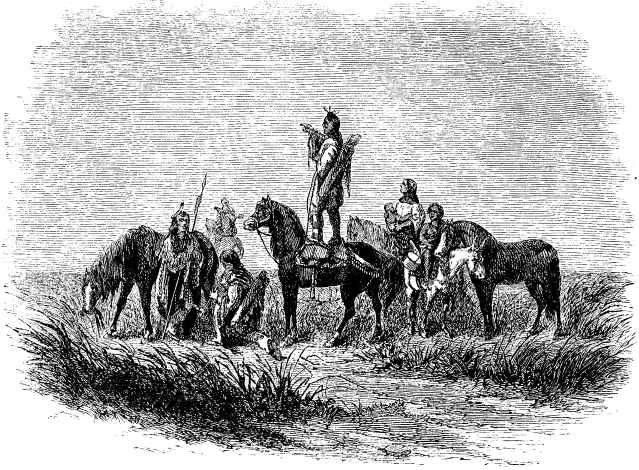SOMETHING ABOUT THE HORSE.
757


NORTH AMERICAN INDIANS AND THEIR PONIES.
quently the “ Indian pony”
possesses less intelligence than he would if he had a more
considerate trainer. When a chief dies they sacrifice his war-steed
over his grave, that he may go well-mounted into the presence of the “
Great Spirit.” The horse, to them, may be considered a vessel to
carry them over their boundless prairies, assist them in hunting the
buffalo, and aid them in their war excursions. Occasionally these
vast fields of vegetation, dried by the summer sun, ignite, and a
conflagration takes place such as can be witnessed nowhere else in the
world. On roll the devouring flames, crackling and exulting, while
the dark clouds of smoke obscure the sun and stifle the atmosphere. It is
on these occasions that the Indian and his horse have a chase for life;
and often, in spite of their combined sagacity and fleetness, they are
overtaken and destroyed.
The same natural causes which
operate to make the home of the horse and of man identical in our own
day, served to bring them together in the first ages of their
existence. The size of the brute rendered it conspicuous; and it is
presumable that he was at first hunted alone as a luxurious food. Compared
with the flesh of the horse that of the ox is coarse in the extreme,
the two presenting all the differences that distinguish the commonest
canvas from the finest cambric. The fibre of the horse is delicate,
and the colors it displays in its perfect form defy the pencil by their
beauty. The muscles of the horse are arranged more symmetrically
than those of any other animal, and the general aspect of the creature's
frame, upon dissection, enforces the idea of a beast of
supe-
rior order. Few have ever made
themselves practically acquainted with the beautiful mechanical
construction of the horse, without imbibing even a higher respect for
him than is realized by the superficial examination of his outside form.
But all this delicacy and beauty rather destroys than tempts the human
appetite, and this circumstance, added to the intrinsic value of the
horse, has discouraged hippophagy —a taste attempted to be revived by many
intelligent “savans” (?) in France. Acceptable as the flesh of the
horse may have been to the palates of the early representatives of
mankind, it is probable they were not able to indulge in an excess of this
kind of food. The animal was difficult to approach, and could hardly be
taken by surprise; once alarmed, pursuit was hopeless, and, in a close
encounter, the issue would be very doubtful. It is, therefore, probable
that the horse was captured by means of pitfalls and similar contrivances
peculiar to all barbarians. The carcass was alone desired—the life of
the victim was in no way regarded.
The Scandinavians and Germans,
devoted to the worship of Odin, raised with the utmost care, in the “
sacred pastures,” a breed of white horses destined for immolation to the
gods which they adored. Once sacrificed, the fumes of their roasting
carcasses were left for the “ superior beings;” the flesh was sensed
up at the festive board. From this custom probably originated
the taste for this kind of food which existed among all the nations of the
north, until Christianity penetrated Europe and succeeded in
destroying the custom, because it was supposed to be directly
connected with the rites of